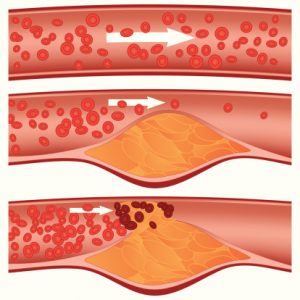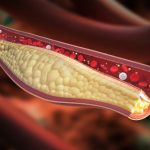 Menopause lowers high density lipoprotein (HDL) protection, increasing the risk of atherosclerosis in women. Atherosclerosis is the narrowing and hardening of the arteries as plaque builds up along their walls. Atherosclerosis can lead to coronary heart disease – responsible for one in three deaths of women.
Menopause lowers high density lipoprotein (HDL) protection, increasing the risk of atherosclerosis in women. Atherosclerosis is the narrowing and hardening of the arteries as plaque builds up along their walls. Atherosclerosis can lead to coronary heart disease – responsible for one in three deaths of women.
When low density lipoprotein (LDL) builds up and accumulates in the arteries, it can contribute to their stiffening and narrowing. LDL cholesterol is known as the “bad” type of cholesterol, while HDL is the good type, known to removes LDL. As LDL cholesterol continues to become thicker along the arteries, it can actually lead to a blockage. When an artery is blocked it can become life-threatening and lead to a heart attack.
Advertisement
Along with smoking and bad cholesterol, menopause, too, is a risk factor for the development of atherosclerosis. Estrogen typically protects women from heart disease, but estrogen levels drop post-menopause. Estrogen helps keep blood vessels strong and flexible, so when estrogen levels drop the arteries can begin hardening. This can make them more prone to damage caused by high LDL levels.
The North American Menopause Society conducted the latest research to reveal the risk menopausal women are at for developing atherosclerosis.
Menopause increases atherosclerosis risk by affecting good cholesterol
 Although HDL typically protects individuals from the effects of LDL cholesterol, in menopausal women this protection becomes lost. The study involved 225 women in their late 40s who had up to five times the plaque build-up over the course of a nine year follow-up. At the baseline scan all women were free from a cardiovascular disease diagnosis.
Although HDL typically protects individuals from the effects of LDL cholesterol, in menopausal women this protection becomes lost. The study involved 225 women in their late 40s who had up to five times the plaque build-up over the course of a nine year follow-up. At the baseline scan all women were free from a cardiovascular disease diagnosis.
Dr. Samar El Khoudary, assistant professor in Pitt Public Health’s Department of Epidemiology, said, “What we found is that, as women transition through menopause, increases in good cholesterol were actually associated with greater plaque buildup. These findings suggest that the quality of HDL may be altered over the menopausal transition, thus rendering it ineffective in delivering the expected cardiac benefits.”
Executive director at the North American Menopause Society, Dr. Wulf Utian, said, “There is such limited data available on this important topic. We need to better understand how all lipids are impacted in order to protect patients from heart disease, which is the number one killer of women in this country.”
Other atherosclerosis risk factors for women
There are many other risk factors aside from menopause that can increase a person’s risk for developing arthrosclerosis. Risk factors include:
- High levels of LDL cholesterol
- High blood pressure
- Smoking
- Insulin resistance or diabetes
- Being overweight or obese
- Lack of physical activity
- Kidney disease
- Unhealthy diet – full of saturated or trans fats, which increase LDL cholesterol
- Older age
- Family history of heart disease
- Inflammation in the body as a response to injury or infection
- High levels of triglycerides
- Sleep apnea
- Stress
- Alcohol consumption
Progression of atherosclerosis at menopause can be slowed by diet
 Diet is a large factor of atherosclerosis because it can contribute to weight gain as well as bad cholesterol. Previous research observed the relationship between the diet of menopausal women and the risk of atherosclerosis. The findings were published in the American College of Cardiology.
Diet is a large factor of atherosclerosis because it can contribute to weight gain as well as bad cholesterol. Previous research observed the relationship between the diet of menopausal women and the risk of atherosclerosis. The findings were published in the American College of Cardiology.
Kim Sutton-Tyrrell from the University of Pittsburg said, “The importance of this paper is that we were able to show that the successful intervention was accompanied by a measurable slowing of the progression of subclinical atherosclerosis that occurs during menopause. These are the first intervention data showing that modification of these risk factors actually slows progression of disease.”
The researchers conducted ultrasounds of carotid arteries in 353 women. Half of the women took part in a lifestyle intervention program which reduced dietary fat and boosted physical activity. Women in the control group received medical check-ups, but did not receive lifestyle check-ups or group sessions.
At the beginning of the study the women were premenopausal and follow-up ultrasounds were taken twice during a four year follow-up. A third measurement was taken 21.2 years later for 113 of the women.
Women in the control group had thickening of their arteries progress faster than the women who had the lifestyle intervention during menopause. Thickening of arteries during menopause in the lifestyle intervention group was much slower.
Dr. Sutton-Tyrell added, “Diet and exercise really work. Not only do they result in lower weight and cholesterol levels, the result is also a slowing of disease progression. This is particularly important for women undergoing the menopausal transition because this is a point at which the progression of disease seems to accelerate. The intervention prevented this acceleration of disease progression that occurs with menopause.”
Not only did Dr. Sutton-Tyrell believe proper diet and exercise was essential for menopausal women, but she also suggested younger women, too, should embark on healthy lifestyle habits in order to keep their arteries healthy. She added, “The issue is that the risk for women accelerates after menopause, so diet and exercise become even more important!”
Dr. Nanette K. Wenger from the Emory University School of Medicine added, “The items to be emphasized are the efficacy of diet and exercise, not only in preventing weight gain and the associated significant reductions in cholesterol and triglycerides, blood pressure and glucose levels in perimenopausal women, but now the observation of efficacy in slowing the progression of atherosclerosis, as ascertained by limitation of progression of carotid intima media thickness.”
Prevention and treatment of atherosclerosis
Advertisement
Although menopause increases a woman’s risk of developing atherosclerosis, the research finds that healthy lifestyle changes can slow down its progression, thus lowering the risk of heart disease and heart attack.
Other prevention tips and treatment of atherosclerosis include:
 Not smoking
Not smoking- Maintaining a healthy weight – losing weight
- Controlling diabetes, hypertension and cholesterol
- Minimizing alcohol consumption
- Avoiding processed food, fast food, junk food in general
- Exercising and increasing physical activity
- Consuming more whole grains, fruits and vegetables, lean protein, and consuming more omegas
- Avoid eating red meat, palm and coconut oils
- Reducing the intake of saturated and trans fats – commonly found in processed foods and red meat
- Reducing sodium intake
- Managing stress
- Considering cholesterol medication if lifestyle habits don’t help
Severe atherosclerosis can be treated by:
- Percutaneous coronary intervention – Doctors open the blocked or narrowed artery in order to improve blood flow.
- Coronary artery bypass grafting – Arteries and veins are used to bypass the narrowed or blocked artery.
- Carotid endarterectomy – Removes plaque build-up. Best procedure to reduce the risk of stroke as it repairs blood flow to the brain.
